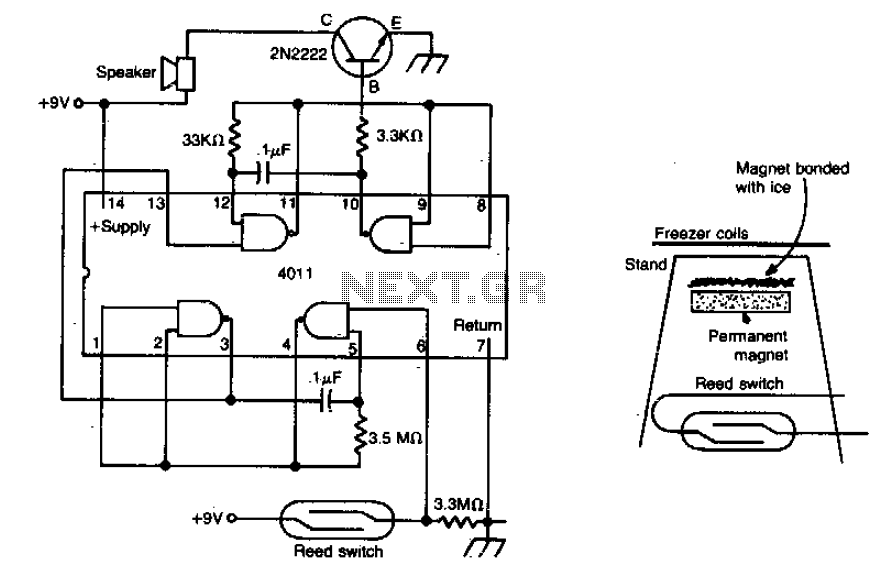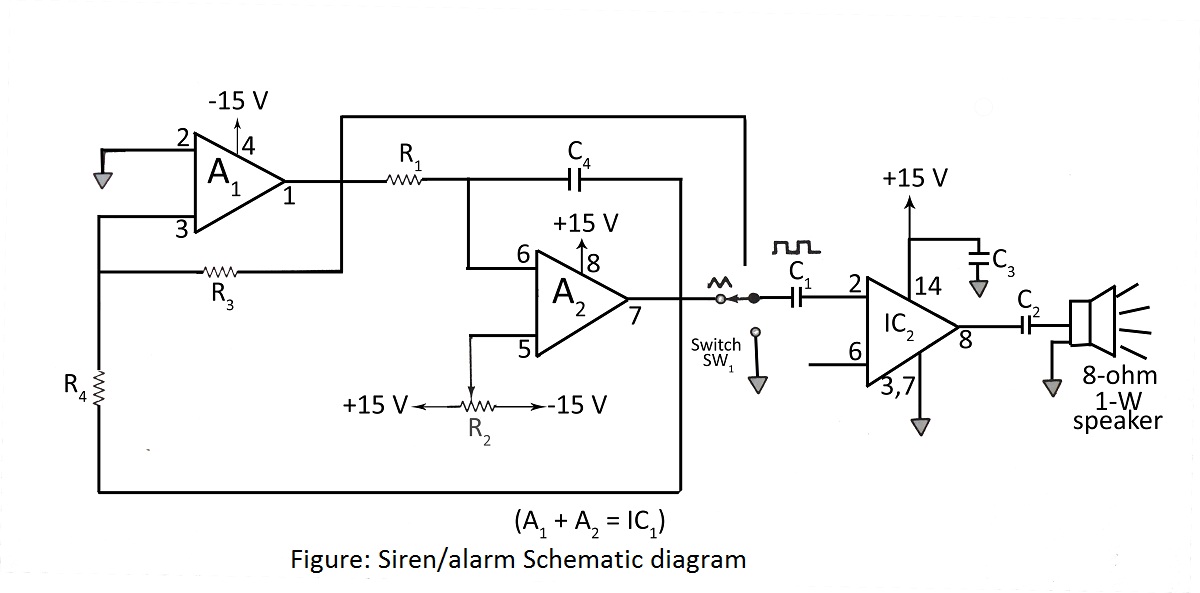
doorknob alarm pcb

Many companies provide simple alarm devices designed for personal use in bedrooms or hotel rooms. A metal chain is attached to a box containing the electronics and is placed around the inside doorknob of a wooden door. When someone attempts to grab the knob from the outside, the device detects the change in electrical capacitance caused by the contact of a human hand with the knob. Most commercial devices utilize a more expensive and power-consuming radio frequency circuit to detect this capacitance change. However, a cost-effective and low-power technique can also be employed. This circuit schematic is intended to significantly lower the device's cost while allowing it to function for many years on a single set of batteries.
The alarm circuit described operates on the principle of capacitance sensing, where the presence of a human hand alters the capacitance between the doorknob and the sensing box. The core components of the circuit typically include a capacitance sensor, a microcontroller, and a power supply. The capacitance sensor is usually designed to detect small changes in capacitance, which can be achieved using a simple RC (resistor-capacitor) circuit.
When the metal chain is wrapped around the doorknob, it acts as one plate of a capacitor, while the box containing the electronics serves as the other plate. The circuit continuously monitors the capacitance levels. When a person touches the doorknob from the outside, the capacitance increases due to the additional capacitance introduced by the human body. This change is detected by the microcontroller, which can be programmed to trigger an alarm or send a signal to alert the user.
The use of a low-power microcontroller is crucial for the longevity of the device, allowing it to operate efficiently on minimal energy. Additionally, the circuit can incorporate a sleep mode, where the microcontroller consumes very little power when not actively monitoring the capacitance. When a change is detected, the microcontroller can wake up and activate the alarm system.
Power supply options for this circuit can include standard batteries or even rechargeable lithium-ion cells, depending on the desired form factor and convenience. The design should also include a low battery indicator to alert users when the power supply is running low.
Overall, this circuit design represents a practical and economical solution for personal security, providing a reliable alarm system with minimal power consumption and cost, suitable for various applications in residential and commercial settings.Circuit Many companies offer simple alarm devices for personal use in bedrooms or hotel rooms. A metal chain attached to a box holding the electronics is placed around the inside doorknob of a wood door. Anyone grabbing the knob from the outside is detected by the electrical capacitance change that occurs from the human hand contact between the kn
ob and the box. Almost all of the commercial devices sold use a more expensive and power consuming radio frequency circuit approach to detect the capacitance change. But, a very inexpensive and micro power technique can also work. This circuit schematic should dramatically reduce the cost of the device and allows it to operate for many years from one set of batteries.
🔗 External reference
The alarm circuit described operates on the principle of capacitance sensing, where the presence of a human hand alters the capacitance between the doorknob and the sensing box. The core components of the circuit typically include a capacitance sensor, a microcontroller, and a power supply. The capacitance sensor is usually designed to detect small changes in capacitance, which can be achieved using a simple RC (resistor-capacitor) circuit.
When the metal chain is wrapped around the doorknob, it acts as one plate of a capacitor, while the box containing the electronics serves as the other plate. The circuit continuously monitors the capacitance levels. When a person touches the doorknob from the outside, the capacitance increases due to the additional capacitance introduced by the human body. This change is detected by the microcontroller, which can be programmed to trigger an alarm or send a signal to alert the user.
The use of a low-power microcontroller is crucial for the longevity of the device, allowing it to operate efficiently on minimal energy. Additionally, the circuit can incorporate a sleep mode, where the microcontroller consumes very little power when not actively monitoring the capacitance. When a change is detected, the microcontroller can wake up and activate the alarm system.
Power supply options for this circuit can include standard batteries or even rechargeable lithium-ion cells, depending on the desired form factor and convenience. The design should also include a low battery indicator to alert users when the power supply is running low.
Overall, this circuit design represents a practical and economical solution for personal security, providing a reliable alarm system with minimal power consumption and cost, suitable for various applications in residential and commercial settings.Circuit Many companies offer simple alarm devices for personal use in bedrooms or hotel rooms. A metal chain attached to a box holding the electronics is placed around the inside doorknob of a wood door. Anyone grabbing the knob from the outside is detected by the electrical capacitance change that occurs from the human hand contact between the kn
ob and the box. Almost all of the commercial devices sold use a more expensive and power consuming radio frequency circuit approach to detect the capacitance change. But, a very inexpensive and micro power technique can also work. This circuit schematic should dramatically reduce the cost of the device and allows it to operate for many years from one set of batteries.
🔗 External reference





